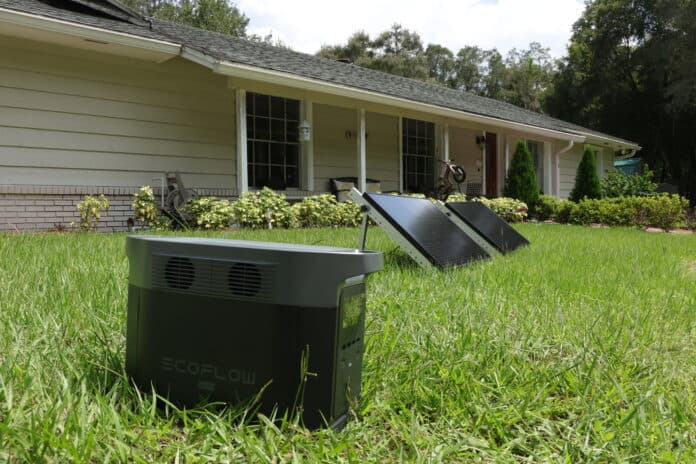There are many reasons to switch from traditional on-grid electric consumption to solar. Whether you want to reduce dependence on the electric company or reduce your carbon footprint, it’s a move that makes sense.
When you make that decision, your thought process must move from ideas to details. You need a system that delivers enough power and provides the physical fit to justify your investment. The right size depends on your home, climate, and usage — all of these factor into how you size the right solar system for your needs.
How Do I Calculate What Size Solar System I Need?
The physical “size” of your solar system is a bit of a misnomer. What you need to do is identify the specific setup that will collect, store, and deliver the energy you need for your home. All things being equal, more panels and surface area to install them amount to more power.
The average United States home uses about 886 kilowatt-hours (kWh) per month. That figure can vary widely depending on where you live, how large your home is, and how many appliances you run. You need to build your solar array based on your expected usage and the set-up available to you.
Essentially, the answers come down to simple math. The following describes the inputs you need to determine how many solar panels you require to deliver sufficient solar energy for your home consumption needs.
1. Calculate Your Daily kWh Usage
Start with your current utility bills to determine the amount of energy your solar panels need to generate. Most utilities provide a monthly number, which may be a precise usage total or an estimate. Collecting data across multiple months will give you a better sense of what your expected usage would be across time.
From here, it’s a simple calculation. Divide the total kWh usage by the number of days covered. If you have six utility bills, you would add the numbers and divide by 180, or the total days in those six months. This figure gives you your daily kWh usage for which you need to build out your solar energy system.
2. Look Up Your Peak Sun Hours
The sun does not shine on your solar panels for 24 hours a day. That doesn’t mean you can’t use solar energy around the clock. Instead, it simply means you are not generating solar power outside of daylight hours.
During peak sunlight hours in your location, your panels absorb, convert, and store the sun’s energy. Your system can then deliver that energy throughout the day and night.
To determine your energy output, you need to know the peak sun hours for where you live.
In areas further south and with lower humidity, the hours of peak sunlight will be greater than in northern or damper areas. Peak sunlight also varies by time of year and more specific location data.
3. Determine Solar Panel Efficiency
Solar panels vary in output depending on their size and efficiency. The construction and quality of photovoltaic panels can lead to output anywhere from 110 watts to 400 watts. The number of panels you need depends on your total usage requirements and the energy you can obtain from each panel.
Calculating the Size of Your Solar System
To calculate the system size you need, begin by converting your daily usage into watts. Multiply that number in kWh by 1,000, giving you the total wattage you need to generate each day. If, for example, your daily usage is 30 kWh, you need to generate 30,000 watt-hours per day.
Next, divide the watt-hours by your peak hours of sunlight. This calculation gives you the total number of watts you need to generate with your solar system. If you need to generate 30,000 watt-hours and have six hours of peak sunlight, your system would need to generate 5,000 watts per day.
Finally, divide this by the wattage per panel in your system. For that 5,000 watts requirement, if your panels generate 250 watts per panel, you’d need 20 total panels for your daily output requirement. If the panels generate only 200 watts, on the other hand, you would need to use 25 panels to achieve the same outcome.
Fine-Tuning Your Estimated Solar System Size
All of the above calculations are straightforward. But accurately calculating your requirements demands more specific data. The average sunlight in your area doesn’t take into account the shade around your house, the size and angle of your roof, or your intended usage. Working with installation experts can help you focus and ensure your SmartHome Ecosystem delivers your actual energy needs.
Get Your Orientation Right
Your roof pitch will direct solar panels toward the sun at different times of the day. Choosing the right side of your roof can mean a difference of several hours of peak time for your system to absorb. Your solar panel positioning should also avoid shade from nearby trees and structures that prevent sunlight from hitting the panels at optimal levels.
How Big Is Your Roof?
As you determine the kind and number of solar panels for your array, you must consider your roof space. While a smaller house typically requires less energy, this is not always the case. A smaller roof may allow for smaller or fewer panels. Measuring your available space can help identify limitations and determine if you require higher-rated power options for your solar panels.
Are You Going Off-Grid?
If your house is connected to the local utility’s electric grid, you typically have a supplemental electricity source readily available. In that situation, underestimating your energy needs carries relatively little risk. On the other hand, off-grid living demands a solar system that allows you to meet all your needs without reliance on the grid. You will need enough solar panels and a solar generator to store the electricity for emergencies.
In some off-grid situations, it may be wiser to invest in a power kit instead of buying the solar panels, power station, and the balance of system separately. A power kit is a modular, space-saving solution for tiny homes, motorhomes, campers, etc. You can find options with a wide range of capacities from 2000Wh to 15kWh.
Cost Considerations
On average, higher-efficiency solar panels are more expensive. The increased solar power generation capacity may be worth it for you. If you have the space for more, less-expensive solar panels, it may make more financial sense for you to go that route instead.
Solar panels represent a significant investment for your home, so you need to take an approach tailored to your needs.
What Size Solar System Do You Need?
In the end, building your solar system requires you to understand your energy needs and include enough panels to provide the output required. Working with a solar power professional gives you access to the expertise you need to help make those assessments for your home.
The right size solar system for you includes the right size and number of panels and the suitable efficiency to achieve the most from the installation. Usually, this means high-efficiency panels, but you should always come back to the size and array that lets you best achieve your goals for the process.
Fine-tuning your energy needs estimate is not the end of the story. You will most likely want to aim just over your typical usage. The extra capacity helps you allow for spikes in need, weather-related reductions in your output, and system lag. Preparing for more will give you peace of mind that you can’t find if you cut your estimate too close. A little more is far better than falling short of what you need.
Conclusion
Making a move to solar power makes sense on both economic and environmental levels. When you are ready to switch, you should assess your energy needs carefully. Your electricity usage, location, and home size all factor into how you can best capture and consume solar energy.
Instead of going it alone, working with a solar energy partner allows you to both access the information you need and proceed with a safe, efficient, and effective installation. The experts at EcoFlow can help you focus on the products you need and provide the installation know-how to set you up for your energy independent solar future.


